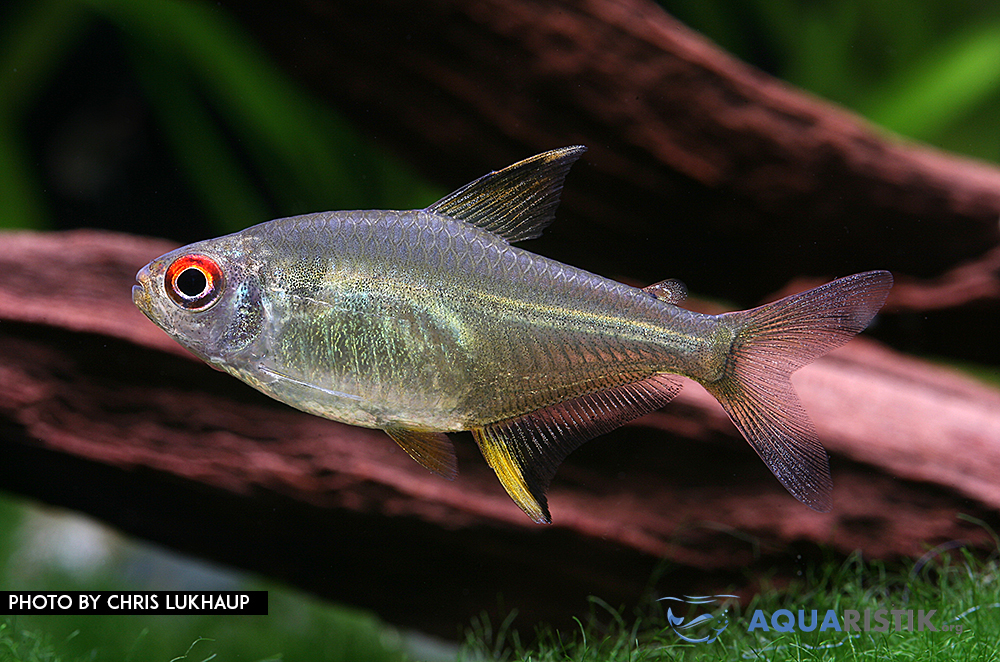Fairfin Tetra or lemon salmer called, Latin of the group Hyphessobrycon pulchripinnis belonging, are also real tetras and show with another special distinguishing feature that they can impress. The picture speaks louder than words and above all shows the distinctive identifying feature on the fins. Below you can find out how to breed the lemon tetra Hyphessobrycon pulchripinnis and what else needs to be considered.

Origin of the lemon tetra Hyphessobrycon pulchripinnis
Since this species of tetra also belongs to the "real" tetras and therefore also to the Characidae and the genus Hyphessobrycon, the origin is already clear for the insider. This fish also comes from South America and lives there in rivers such as the Rio Tocantins, which is also in the Amazon basin in the Brazilian area. The Tapajos river basin in particular is one of its main areas of origin. The lemon tetra is also a fish that lives in blackwater bodies of water. These bodies of water are usually characterized by the rather acidic water. Nevertheless, the lemon tetra finds enough other water parameters in our aquariums today.
This tetra species is also considered to be extremely peaceful and can sometimes become shy if the stocking and the planting do not fit.
Characteristics and appearance of the lemon tetra
This species also has a rather high-backed shape and is therefore less long. The size is given as a maximum of 5 cm. The body is grey-green and shimmers more yellow, which also accounts for the name of the lemon tetra. However, the main distinguishing feature can be found in the area of the fins, because that is where the lemon tetra shows its true beauty. In addition to a black border, there are also yellow spots that shimmer extremely in the right light. Even the small adipose fin can still have this particular yellow-black coloration.
Another striking feature are the eyes, or to be more precise, the coloring of these, because the upper area is framed in red. Of course, you will also find some different colorings in the lemon tetras, because certain color differences can emerge, especially through breeding.
The age of the animals is usually given as up to 5 years. As mentioned above, lemon tetras are very peaceful animals. They can be socialized with almost any fish.
Keeping and care or water parameters of lemon tetras
Of course, the water hygiene must also be right for this species of tetra and you cannot do without a water change. You also have to make sure that the temperature is in the range of 22 to 28 degrees because the animals come from a tropical environment. Also with the PH value you should avoid a value of over 7,5. In addition, the water should not go below 6, which is very acidic. This makes the lemon tetra quite robust.
You also have to be careful with the hardness, because the water should be particularly soft and the hardness should not exceed 8 degrees. As always, you can find out with a droplet or strip test.
The lemon tetra must be kept in a group of at least 8 animals. Although there are exceptions and the animals are kept from 60 liters and there only in a group of 6 animals, we recommend not to go below an edge length of 80 cm and thus to care for a larger group. Pools with a water capacity of 150 - to 200 liters also allow a nice group of up to 20 animals.
When it comes to food, these tetras also make few demands. You should not only give dry food, but also frozen food and live food. A balanced diet distinguishes the fish particularly beautifully in its colors and lets them shine magnificently and strongly.
- Aquarium from 80 cm
- Groups of 8 animals or more
- PH value from 6 to 7,5
- school fish
- Temperature of 22 – 28 degrees
- frozen food, live food and dry food
Breeding and reproduction of the lemon tetra
Basically, there are few differences here in terms of reproduction compared to the other tetras. Unfortunately, it is not easy to breed the lemon tetra successfully here either. Above all, you need a female who is willing to spawn. The best way to try your luck is to keep a surplus of females.
But before you start breeding two males and four females, you have to make sure that the water has the appropriate values. Especially a very soft acidic water should be used in breeding. Values of Gh around 5 and Ph around 6,5 have proven themselves. The tank should have good planting and the lighting should also be dimmed a little.
Lemon tetras are also spawn robbers and eat their eggs. That's why we recommend one here spawning grid to use in the breeding tank. In addition, the parents should be removed immediately after spawning.
Once the young have hatched, they first feed on their yolk sac. The young hatch after just one day. You have to feed them accordingly after about 4 days, because then the yolk sac is used up. We recommend Artemia Naupien or small infusion animals. If you have enough floating plants in the tank, then that can be enough as the first food. Later you can also pass powdered food.






